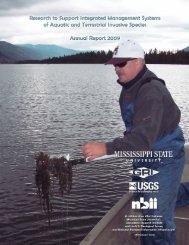Bushkiller - Geosystems Research Institute - Mississippi State ...
Bushkiller - Geosystems Research Institute - Mississippi State ...
Bushkiller - Geosystems Research Institute - Mississippi State ...
Create successful ePaper yourself
Turn your PDF publications into a flip-book with our unique Google optimized e-Paper software.
<strong>Bushkiller</strong><br />
[Cayratia japonica (Thunb.) Gagnepain]<br />
Victor Maddox, Ph.D., Postgraduate <strong>Research</strong> Assistant, <strong>Mississippi</strong> <strong>State</strong> University<br />
John D. Byrd Jr., Ph.D., Extension/<strong>Research</strong> Professor, <strong>Mississippi</strong> <strong>State</strong> University<br />
Randy Westbrooks, Ph.D., Biological <strong>Research</strong>er, U.S. Geological Survey<br />
Wildland<br />
Fig. 1. <strong>Bushkiller</strong> grows on a white pine<br />
with English ivy.<br />
Introduction<br />
Problems caused<br />
<strong>Bushkiller</strong> [Cayratia japonica (Thunb.) Gagnep.][Syn. Causania japonica (Thunb. ex Murray) Raf.; Cissus japonica<br />
(Thunb. ex Murray) Willd.; Cissus tenuifolia F. Heyne ex Planch.; Cissus tenuifolia F. Heyne in Wall.; Columella japonica<br />
(Thunb. ex Murray) Merr.; Vitis japonica Thunb. ex Murray; Vitis tenuifolia (F. Heyne) Laws in Hook.f.] is an evergreen to<br />
deciduous, perennial woody vine native to southeast Asia and Australia. The extent of its invasion is not clear, but new<br />
locations have been reported and efforts are underway to map and monitor its spread.<br />
Regulations<br />
<strong>Bushkiller</strong> is not regulated in the United <strong>State</strong>s, although there is interest. It continues to spread in the MidSouth, especially<br />
Louisiana.<br />
Description<br />
Fig. 2. <strong>Bushkiller</strong> has small orange or salmoncolored<br />
sterile flowers.<br />
Fig. 3. <strong>Bushkiller</strong> has compound leaves with five<br />
leaflets and alternate leaf arrangements.<br />
Vegetative growth<br />
<strong>Bushkiller</strong> is a high-climbing vine that has tendrils, similar to grapes. Vines can be somewhat fleshy. Roots are also<br />
fleshy and can produce many adventitious shoots especially when cut or disturbed. Leaves are compound with five leaflets<br />
and alternate leaf arrangement. Leaves vary in size, but tend to be around 5’’ long and slightly less in width. Leaflets<br />
are smooth and shiny with serrate leaf margins.<br />
Flowering/fruiting<br />
The small salmon- or orange-colored flowers are orange and born in flat-topped inflorescences. Despite an abundance<br />
of potential pollinators, bushkiller is apparently sterile. Normally bushkiller would produce a 2-4- seeded berry. Since<br />
flowers are bisexual, the reason for sterility is not clear.<br />
Dispersal mechanisms<br />
Since bushkiller is sterile, it apparently only spreads vegetatively in the United <strong>State</strong>s. More research is needed to understand<br />
sterility, since the absence of seed is a key component in limiting the spread of bushkiller.<br />
Spread by<br />
It is spread primarily by humans and possibly certain natural events such as flooding.<br />
Habitat<br />
Vines can climb trees and other structures by tendrils, becoming quite large in the absence of severe cold weather. The<br />
weight of the fleshy vines can break tree branches. Foliage can be dense and block out sunlight from plants it grows on.<br />
It can also compete for other resources, such as water. It is not clear what ecological communities or plant species are at<br />
the greatest risk due to bushkiller in the United <strong>State</strong>s. However, it is adventive where escaped and could be a serious<br />
invader at least in the southern United <strong>State</strong>s. In cooler climates, such as Zone 7b, plants may freeze to the ground and<br />
re-grow from undergrounds roots in the spring.
Distribution<br />
US<br />
<strong>Bushkiller</strong> is native to Southeast Asia and Australia and reported in Japan, southern China, Indo-China, the Philippines,<br />
Taiwan, New Caledonia, New Guinea, and Queensland. <strong>Bushkiller</strong> was cultivated in the United <strong>State</strong>s sometime before<br />
1964, but has escaped in the southern U.S. with known occurrences in California, Louisiana, <strong>Mississippi</strong>, North Carolina,<br />
and Texas. It has survived winters in Zone 7b, although foliage was severely damaged.<br />
MidSouth<br />
In the MidSouth, bushkiller occurs in Louisiana and <strong>Mississippi</strong>. In <strong>Mississippi</strong>, its occurrences in new counties continue<br />
to be reported. Currently, it has been reported in Jackson, Lincoln, Pike, and Webster Counties in <strong>Mississippi</strong>. In Louisiana,<br />
it occurs at scattered localities but forms dense stands in areas near the <strong>Mississippi</strong> River from Baton Rouge to<br />
Control Methods<br />
Biological<br />
No biological controls are currently being utilized for bushkiller control.<br />
Chemical<br />
More research is needed on bushkiller control, since there are no label recommendations.<br />
Mechanical<br />
Mechanical controls can be used for bushkiller control, but tend to be expensive and labor intensive. Roots left in the soil<br />
can regenerated shoots, thus hand removal must be thorough. Pulling shoots without removing roots can take a long<br />
period of time and probably not a feasible means of eradication.<br />
References<br />
USDA, NRCS. 2007. The PLANTS Database (http://plants.usda.gov, 6 August 2007). National Plant Data Center, Baton<br />
Rouge, LA 70874-4490 USA.<br />
More Information<br />
There are 63 species of Cayratia A.L. Jussieu distributed mostly in tropical and subtropical Africa, Asia, Australia, and<br />
the Pacific Islands. The Genus Cayratia belongs to the Grape Family (Vitaceae) and apparently only one species, bushkiller<br />
(C. japonica), occurs in the continental United <strong>State</strong>s. Cayratia trifolia (L.) Domin occurs in Hawaii.<br />
John D. Madsen, Ph.D.<br />
<strong>Mississippi</strong> <strong>State</strong> University, <strong>Geosystems</strong> <strong>Research</strong> <strong>Institute</strong><br />
Box 9652, <strong>Mississippi</strong> <strong>State</strong>, MS 39762-9652<br />
Ph. (662)325-2428, jmadsen@gri.msstate.edu<br />
www.gri.msstate.edu




